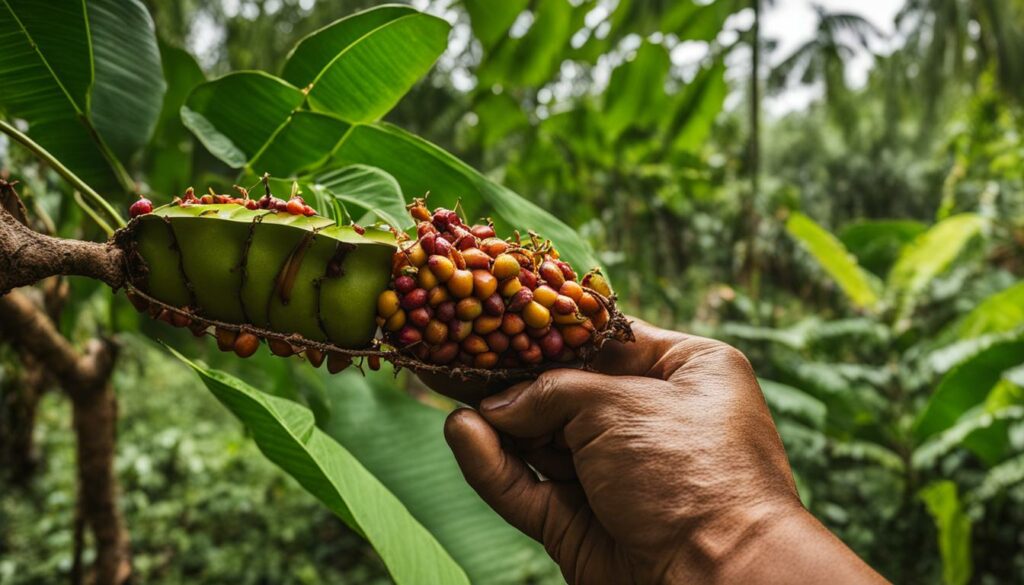Welcome to our comprehensive Tamarind Tree Plant Care Guide! If you’re wondering how to care for a tamarind tree, look no further. Whether you’re an experienced gardener or a novice, growing tamarind trees can be a rewarding and enjoyable experience. With our expert tips and advice, you’ll learn everything you need to know about tamarind tree care, from planting and pruning to dealing with pests and diseases.
Tamarind trees, native to Africa and found in various parts of the world, are known for their beautiful foliage, vibrant flowers, and delicious fruit. These evergreen trees can reach impressive heights and have a lifespan of over 300 years. But don’t worry, they are surprisingly low maintenance and easy to grow.
In this guide, we’ll cover topics such as tamarind tree varieties, proper planting techniques, essential care tips, and the incredible benefits of using tamarind in your culinary creations. So, whether you’re interested in growing tamarind trees for their ornamental value or for their tasty fruit, we’ve got you covered.
So, let’s dive in and learn how to make your tamarind trees thrive. Get ready to unlock the secrets of successful tamarind tree care and enjoy the many rewards it brings!
Tamarind Tree Varieties
Tamarind trees come in various varieties, each with its own unique characteristics and flavors. Here are some popular tamarind tree varieties:
- Sweet Tamarind: This variety is known for its sweet and tangy flavor. It produces large, sweet tamarind fruits that are commonly used in desserts and candies.
- Australian Tamarind: Also known as the “wild tamarind,” this variety is native to Australia. It has a milder flavor compared to other varieties and is often used in chutneys and sauces.
- Manila Tamarind: This variety is commonly found in the Philippines and has a sweet and sour taste. The fruits are small and round, and the pulp is used in various culinary preparations.
- Velvet Tamarind: Native to West Africa, the velvet tamarind has a velvety texture and a sour and slightly sweet taste. The fruits are small, round, and covered with a velvety husk.
- Spanish Tamarind: This variety is mainly found in Central America and has a distinct sour flavor. It is often used in beverages, sauces, and marinades.
These are just a few examples of the tamarind tree varieties available. Each variety has its own unique taste and culinary uses, making them a versatile addition to any garden or culinary repertoire.
Table: Comparison of Tamarind Tree Varieties
| Variety | Flavor | Fruit Size | Uses |
|---|---|---|---|
| Sweet Tamarind | Sweet and tangy | Large | Desserts, candies |
| Australian Tamarind | Mild | Medium | Chutneys, sauces |
| Manila Tamarind | Sweet and sour | Small | Culinary preparations |
| Velvet Tamarind | Sour and slightly sweet | Small | Beverages, sauces |
| Spanish Tamarind | Sour | Medium | Beverages, sauces, marinades |
Planting Tamarind
Planting a tamarind tree requires careful consideration of the location, soil conditions, and climate. Here are some important steps to follow for successful tamarind tree planting:
Choosing the Right Location
Tamarind trees thrive in full sun, so it’s essential to select a spot in your garden that receives at least 6-8 hours of direct sunlight daily. The tree also requires well-draining soil to prevent waterlogging, which can cause root rot. If your soil is heavy or clayey, add organic matter like compost or well-rotted manure to improve drainage.
Preparing the Planting Hole
Dig a hole that is twice the size of the root ball of your tamarind tree. Gently remove the tree from its pot and place it in the hole, ensuring that the top of the root ball is level with or slightly above the ground. Backfill the hole with soil, firming it gently around the tree to eliminate air pockets.
Watering and Mulching
After planting, water the tamarind tree thoroughly to settle the soil and provide moisture to the roots. A deep watering once a week is generally sufficient. Apply a layer of mulch around the base of the tree to help conserve moisture, regulate soil temperature, and suppress weed growth. Avoid piling the mulch against the tree trunk, as this can create a damp environment that promotes rot.
Spacing
The planting density for tamarind trees can vary depending on the variety and the desired growth. For commercial growers, spacing of 5-15 meters is recommended to allow sufficient room for proper growth and development. However, if you’re planting tamarind trees in a home garden, consider the size of your outdoor space and the potential size of the tree at maturity when determining the spacing.
By following these guidelines, you can ensure the successful planting of a tamarind tree and set the stage for its healthy growth and development.
Tamarind Tree Care
Proper care and maintenance are essential for the health and longevity of your tamarind tree. By following a few simple guidelines, you can ensure that your tree thrives and produces abundant fruit.
Watering
Tamarind trees require regular watering, especially during dry spells. However, it is important not to overwater the tree as this can lead to root rot. A good rule of thumb is to water deeply once a week, allowing the soil to dry out between waterings. Adjust the frequency based on the weather conditions and the moisture needs of your specific tree.
Pruning
Regular pruning is essential to maintain the shape and size of your tamarind tree. Prune any dead or diseased branches, as well as any branches that are crossing or rubbing against each other. This will improve air circulation and prevent the spread of diseases. Pruning should be done during the dormant season to minimize stress on the tree.
Pest and Disease Control
Tamarind trees are susceptible to a variety of pests and diseases. Common pests include scales, mealy bugs, aphids, and fruit borers. To control pests, regularly inspect your tree and remove any affected parts. You can also use insecticidal soaps or organic pesticides. In terms of diseases, tamarind trees can be affected by root rot, sooty mold, and leaf spot. Proper watering, good drainage, and regular fertilization can help prevent these diseases.
| Pest/Disease | Symptoms | Treatment |
|---|---|---|
| Scales | Presence of small, raised bumps on leaves and stems | Prune affected branches and use insecticidal soap |
| Root Rot | Yellowing and wilting of leaves, stunted growth | Improve drainage, avoid overwatering |
| Sooty Mold | Black, powdery substance on leaves, honeydew secretion | Prune affected areas and improve air circulation |
Giving your tamarind tree proper care and attention will not only ensure its well-being but also maximize its fruit production. With a little effort, you can enjoy the beauty and benefits of this remarkable tree for years to come.
Using Tamarind
Tamarind is a versatile fruit that is widely used in various culinary preparations. Its unique flavor profile adds a tangy and sour taste to dishes, making it a popular ingredient in many cuisines around the world. From savory dishes to sweet treats, tamarind offers a range of possibilities in the kitchen.
Tamarind pulp: The pulp extracted from tamarind pods is the most commonly used form of tamarind in cooking. It is known for its distinct sweet and tart flavor, which is highly valued in South Asian cuisines. Tamarind pulp is often used as a base for chutneys, sauces, and marinades. It can also be added to soups, curries, and stir-fries to enhance their flavor.
Tamarind drinks: Tamarind is also used to make refreshing beverages. Tamarind juice or concentrate can be mixed with water, sugar, and spices to create a tangy and revitalizing drink. In some cultures, tamarind is fermented to make traditional alcoholic beverages like tamarind wine or tamarind-infused spirits.
Tamarind in desserts: Tamarind’s unique combination of sweet and sour flavors makes it a delightful addition to desserts. Tamarind can be used to make jams, jellies, candies, and even ice cream. Its natural acidity and rich color add depth and complexity to sweet treats.
| Tamarind Recipes | Cuisine | Key Ingredients |
|---|---|---|
| Tamarind Chutney | Indian | Tamarind pulp, jaggery, spices |
| Pad Thai | Thai | Tamarind paste, rice noodles, shrimp/chicken/tofu |
| Tamarind Margarita | Mexican | Tamarind concentrate, tequila, lime juice, agave syrup |
| Tamarind Popsicles | International | Tamarind pulp, sugar, water |
Tamarind Chutney Recipe
If you’re looking to try a classic tamarind recipe, here’s a simple and delicious tamarind chutney recipe from Indian cuisine:
- Soak half a cup of tamarind pulp in warm water for 15-20 minutes.
- Strain the soaked tamarind pulp and discard the seeds and fibers.
- In a saucepan, heat a tablespoon of oil and add cumin seeds, mustard seeds, and curry leaves.
- Add finely chopped onions, ginger, and garlic, and sauté until golden brown.
- Add the strained tamarind pulp, jaggery, salt, red chili powder, and water to the saucepan.
- Cook on low heat for 15-20 minutes until the chutney thickens.
- Allow the chutney to cool and store it in an airtight container in the refrigerator.
Enjoy this tangy and flavorful tamarind chutney with samosas, pakoras, or as a condiment for grilled meats and vegetables.

Conclusion
Growing and caring for a tamarind tree can be a rewarding experience, whether you have a large outdoor space or a small container garden. By following the proper care guidelines, you can ensure the health and vitality of your tamarind tree.
From its beautiful foliage and flowers to its versatile fruits and numerous health benefits, the tamarind tree is truly a remarkable plant. The tree’s evergreen leaves resemble acacia leaves, while its yellow flowers with red streaks add a touch of beauty to any garden. The tamarind fruit, with its sour and sweet pulp, is a popular ingredient in various culinary preparations and offers a unique flavor profile.
In addition to its culinary uses, the tamarind tree also offers several health benefits. It is rich in carbohydrates, protein, and tartaric acid, as well as vitamins B1, B2, B3, B5, B6, and C, and minerals like calcium, iron, magnesium, phosphorus, potassium, sodium, and zinc. Tamarind has antioxidant, anti-inflammatory, antimicrobial, and antiviral properties, making it a valuable addition to one’s diet.
Consider adding a tamarind tree to your garden and enjoy the many benefits it has to offer. Whether you’re looking to enhance your cooking, create a tropical ambiance, or simply appreciate the beauty of nature, the tamarind tree is sure to bring joy and satisfaction to your gardening endeavors.
FAQ
What is a tamarind tree?
A tamarind tree is a tropical tree native to Africa and found in various parts of the world. It can reach a height of 25 meters and has evergreen leaves and beautiful yellow flowers.
How do you plant a tamarind tree?
Choose a location with full sun and well-draining soil. Dig a hole twice the size of the root ball, remove the plant from the pot, fill the hole with soil, and water the plant thoroughly.
How do you care for a tamarind tree?
Spread mulch around the base of the tree, prune regularly, and protect from pests and diseases. Fertilize with organic fertilizer and apply compost and manure for optimal health.
What are the different types of tamarind varieties?
There are various types, including Sweet Tamarind, Australian tamarind, Manila tamarind, Velvet tamarind, and Spanish Tamarind. Each variety has its own unique characteristics and flavors.
How do you use tamarind in cooking?
Tamarind fruits are commonly used in juices, sauces, jams, and beverages. The pulp is a key ingredient in South Asian cuisines and curry recipes. It is rich in carbohydrates, protein, and tartaric acid.





